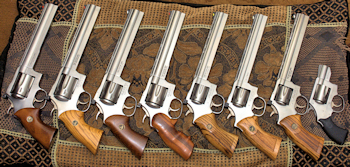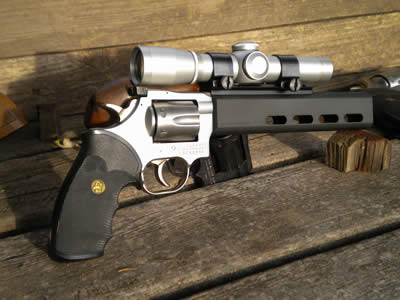UPDATE: This information has been updated on THR and includes much new info-Steve
http://www.thehighroad.org/showthread.php?t=695644
By Jim March
So you're buying a revolver. New, used, doesn't matter, you want a good one, right? How do check one over without firing it, right at the dealer's counter or gun show table? This is how. All of this works with DA or SA wheelguns…”close the action” on most DAs means swing the cylinder in, on SA types, close the loading gate, on break opens, close 'em. UNLOADED.
WARNING: most of these tests require violation of the “finger off trigger” rule. Therefore, be extremely careful about safe muzzle direction and making sure the gun is unloaded ahead of time, PERSONALLY, as you begin handling it.
Note: bring a small flashlight, something small and concentrated. A Photon or similar high-powered LED light is perfect. You also want feeler gauges if you're not used to eyeballing cylinder gaps; at a minimum, bring a .002″, .004″ and .006″.
Note 2: no dry firing is required or desired at any point. It just pisses off the gun's current owner.
Cylinder play
1) With the gun UNLOADED (check for yourself!), close the action.
2) Thumb the hammer back, and while pulling the trigger, gently lower the hammer all the way down while keeping the trigger back - and KEEP holding the trigger once the hammer is down. (You've now put the gun in “full lockup” - keep it there for this and most other tests.)
3) With the trigger still back all the way, check for cylinder wiggle. Front/back is particularly undesirable; a bit of side to side is OK but it's a bad thing if you can wiggle it one way, let go, and then spin it the other way a fraction of an inch and it stays there too. At the very least, it should “want” to stop in just one place (later, we'll see if that place is any good). The ultimate is a “welded to the frame” feeling.
Cylinder gap
4) Still holding the trigger at full lockup, look sideways through the barrel/cylinder gap. If you can get a credit card in there, that ain't good…velocity drops rapidly as the gap increases. Too tight isn't good either, because burnt powder crud will “fill the gap” and start making the cylinder spin funky. My personal .38 snubbie is set at .002, usually considered the minimum…after about 40 shots at the range, I have to give the front of the cylinder a quick wipe so it spins free again. I consider that a reasonable tradeoff for the increased velocity because in a real fight, I ain't gonna crank 40 rounds out of a 5-shot snub.
If you're eyeballing it, you'll have to hold it up sideways against an overhead light source.
Timing
5) You really, REALLY want an unloaded gun for this one. This is where the light comes in. With the gun STILL held in full lockup, trigger back after lowering the hammer by thumb, you want to shine a light right into the area at the rear of the cylinder near the firing pin. You then look down the barrel . You're looking to make sure the cylinder bore lines up with the barrel. Check every cylinder - that means putting the gun in full lockup for each cylinder before lighting it up.
You're looking for the cylinder and barrel holes to line up perfectly, it's easy to eyeball if there's even a faint light source at the very rear of both bores. And with no rounds present, it's generally easy to get some light in past where the rims would be.
Bore
(We're finally done with that “full lockup” crap, so rest your trigger finger. )
6) Swing the cylinder open, or with most SAs pull the cylinder. Use the small flashlight to scope the bore out. This part's easy - you want to avoid pitting, worn-out rifling, bulges of any sort. You want more light on the subject than just what creeps in from the rear of the cylinder on the timing check.
You also want to check each cylinder bore, in this case with the light coming in from the FRONT of each hole, you looking in from the back where the primers would be. You're looking for wear at the “restrictions” at the front of each cylinder bore. That's the “forcing cone” area and it can wear rapidly with some Magnum loads. (Special thanks to Salvo below for this bit!)
Trigger
7) To test a trigger without dry-firing it, use a plastic pen in front of the hammer to “catch” it with the off hand, especially if it's a “firing pin on the hammer” type. Or see if the seller has any snap-caps, that's the best solution. Flat-faced hammers as found in transfer-bar guns (Ruger, etc) can be caught with the off-hand without too much pain .
SA triggers (or of course a DA with the hammer cocked) should feel “like a glass rod breaking”. A tiny amount of take-up slack is tolerable, and is common on anything with a transfer bar or hammer block safety.
DA triggers are subjective. Some people like a dead-smooth feel from beginning of stroke to the end, with no “warning” that it's about to fire. Others (myself included) actually prefer a slight “hitch” right at the end, so we know when it's about to go. With that sort of trigger, you can actually “hold it” right at the “about to fire” point and do a short light stroke from there that rivals an SA shot for accuracy. Takes a lot of practice though. Either way, you don't want “grinding” through the length of the stroke, and the final stack-up at the end (if any) shouldn't be overly pronounced.
Detecting Bad Gunsmithing:
![]() OK, so it's got a rock-solid cylinder, a .002″ or .003″ gap, and the trigger feels great. Odds are vastly in favor of it being tuned after leaving the factory.
OK, so it's got a rock-solid cylinder, a .002″ or .003″ gap, and the trigger feels great. Odds are vastly in favor of it being tuned after leaving the factory.
So was the gunsmith any good?
Look at the screws. Ideally, they should be untouched, meaning that the gun has not been messed with. If the screw heads are battered and worn, it means the sideplate has been off, probably many times. A gun like that may have a smooth trigger, but the parts may have been polished out of time or (if a S&W) the case hardening cut through so the parts will wear out rapidly. Many guns subjected to amateur gunsmithing turn up on the used gun market when the guy realizes he has messed up.
Next, cock it, then grab the hammer and “wiggle it around” a bit. Not too hard, don't bang on it, but give it a bit of up/down, left/right and circular action with finger off trigger and WATCH your muzzle direction.
You don't want that hammer slipping off an overly polished sear. You REALLY don't want that . It can be fixed by installing factory parts but that'll take modest money (more for installation than hardware costs) and it'll be big time unsafe until you do.
The other thing that commonly goes wrong is somebody will trim the spring, especially coil springs. You can spot that if you pull the grip panels, see if the spring was trimmed with wire cutters. If they get too wild with it, you'll get ignition failures on harder primers. But the good news is, replacement factory or Wolf springs are cheap both to buy and have installed.
There's also the legal problems Ayoob frequently describes regarding light triggers. If that's a concern, you can either swap back to stock springs, or since you bought it used there's no way to prove you knew it was modified at all .
In perspective:
Timing (test #5) is very critical…if that's off, the gun may not even be safe to test-fire. And naturally, a crappy barrel means a relatively pricey fix.
Cylinder gap is particularly critical on short-barreled and/or marginal caliber guns. If you need every possible ounce of energy, a tight gap helps. Some factory gaps will run as high as .006″; Taurus considers .007″ “still in spec” (sigh). You'll be hard-pressed to find any new pieces under .004″ - probably because the makers realize some people don't clean 'em often (or very well) and might complain about the cylinder binding up if they sell 'em at .002″.
The guns in a dealer's “used pile” are often of unknown origin, from estate sales or whatever. Dealers don't have time to check every piece, and often don't know their history. These tests, especially cylinder gap and play, can spot a gun that's been sent off for professional tuning…like my snubbie, the best $180 I ever spent .
As long as the gun is otherwise sound (no cracks, etc) a gunsmith can fix any of this. So these tests can help you pick a particularly good new specimen, or find a good used gun, or help haggle the price down on something that'll need a bit of work.
This article was originally a webboard post at http://www.thefiringline.com/forums/…threadid=57816 from Jim March and re-published with permission and has had minor changes from the original post based on additional information contributed by others in that discussion thread. You can find Jim online at http://www.ninehundred.com/~equalccw/
Jim March
TFL Alumnus
Equal Rights for CCW Home Page
http://www.equalccw.com
Airplane Pictures
Range Officer

Range Officers

Dans Club
February 9, 2009
 Offline
OfflineI keep the .375SM and .22 LR at .006. I keep most others between .002 and .004 depending on the face of the cylinder of the specific gun and if I plan to shoot lead from them that will build up on the face. I hope this guides you a bit, even though it was not a straight forward answer.
A man cannot have too many SuperMags
November 13, 2009
 Offline
OfflineI'm a compulsive gun cleaner and don't plan on using lead bullets so build-up shouldn't be an issue for me. I like the idea of keeping the gap tighter to keep velocity up, thanks for the advice guys. I wonder why DW supplies the .006" gauge if that is up towards the higher end of what is usually condisered "acceptable"?
Supporter
Range Officer

Range Officers
May 2, 2009
 Offline
Offlinefalar said:I'm a compulsive gun cleaner and don't plan on using lead bullets so build-up shouldn't be an issue for me. I like the idea of keeping the gap tighter to keep velocity up, thanks for the advice guys. I wonder why DW supplies the .006" gauge if that is up towards the higher end of what is usually condisered "acceptable"?
the honest answer is .006 kept people from calling back to DW complaining that their cylinder keeps "binding up". With .006 you can shoot it and not clean it and it will keep turning. With a tighter gap and dirty/lead loads you need to keep the cylinder face cleaned up for proper operation.
SHOOT

Dans Club
March 2, 2008
 Offline
OfflineOne very small disclaimer on tighter gaps-check each chamber for gap, there can be minor variations, then set gap on the tightest one
I went to a bookstore and asked the saleswoman "Were is the Self Help Section?" She said if she told me, it would defeat the purpose.
George Carlin
Range Officer

Range Officers

Dans Club
February 28, 2009
 Offline
OfflineDecember 12, 2009
 Offline
OfflineWe have found that gap can affect accuracy, My DW 15 is a nightmare on any setting but 6. The groups at 15 yards on 2,3,4,5,7,8. Are about a 1 1/2 to 2 inches. On 6 it will shoot 1/2 groups all day long. But have have seen other DW that just do not care. My 40 will bind up constantly at a 2. But groups about the same anywhere you set it. So as I shoot pins and time is of the essence, reliability is a must. I put fired brass with no primers in the chambers. Then I tighten the gap to 1 and cycle the action a take a reading behind the firing pin with the hammer in the cocked position on all cylinders. As I back it off the reading will start to get consistent. Then rotate brass and check again, as brass as differing tolerances. The repeat to the front on barrel cylinder. Then I stop backing it off, and I tighten. This is a excellent to see if you cylinder is true. (Mark tight cylinders). Anyways, I alway end up with a barrel cylinder at a tight 3 with that gun. I always on every DW set the gap with fired brass in the chambers, and cycle to make sure it is consistent. As every gun is it's own animal, cylinder gap could improve you scores and reliability.
May 3, 2010
 Offline
OfflineSomething else that should be inspected on the small frame Dans: Check the area of the frame surrounding the firing pin for peening. I was going to purchase a 10" 15-2 which had been used in IHMSA competition for years. With the cylinder gap set at .002 (like it always was on this particular gun) the primer flowed back into the peened area of the frame and locked up the cylinder.....
Range Officer

Range Officers

Dans Club
March 27, 2009
 Offline
OfflineMay 23, 2012
 Offline
Offline1 Guest(s)

 Register
Register Log In
Log In Home
Home

















